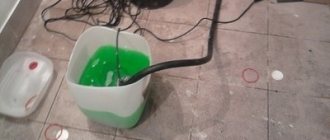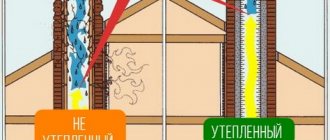Making your own antifreeze
It should be immediately noted that ordinary water is the best type of coolant. It has sufficient heat capacity, has optimal density, and is affordable. Therefore, if the likelihood of exposure to negative temperatures affecting the heat supply is minimal, it is best to use distilled water.
But if this condition cannot be met, a special non-freezing liquid for heating boilers will be required. It is a solution in which water occupies up to 70% of the total volume. The rest is additives that reduce the crystallization threshold to -60°C. They include:
- The main component is ethylene glycol, propylene glycol or glycerin. This non-freezing liquid for the home heating system has a high viscosity coefficient, which leads to the desired effect;
- Additives . It is thanks to them that the non-freezing liquid for water heating does not foam and does not form a crystalline precipitate when the temperature rises.
The problem with making such a composition yourself is the correct selection of the last component. All manufacturers do not disclose the full list of components. But even knowing how to make the correct composition, it is impossible to do this at home - this will require special equipment and adherence to manufacturing technology.
How to make your own non-freezing liquid for heating, and what consequences can its use lead to?
- An increase in the level of foam during heating of the coolant will lead to the rapid formation of sediment on the walls of pipes and radiators;
- Reducing the heat transfer of homemade antifreeze liquid. This will cause a significant decrease in heating efficiency;
- Do-it-yourself non-freezing heating fluid can have a negative effect on the steel elements of the system due to the high oxygen content. Corrosion processes will accelerate.
Any non-freezing liquid for stove heating or solid fuel boiler should not cause these undesirable effects. Therefore, to maintain the safety of the system, it is recommended to use only high-quality antifreeze liquid for water heating from a reliable manufacturer.
Before using antifreeze, you should familiarize yourself not only with its composition and recommendations for use, but also carefully study the instructions for the heating boiler. It should indicate the types of coolant that can be filled.
Why should you change?
Coolant is needed to control engine temperature. When the engine is running, fuel is burned. In this case, high temperatures are detected inside the cylinders. As a result, thermal energy heats the metal elements of the engine - pistons, cylinder head, cylinders.
Thanks to a sophisticated cooling system, the liquid collects heat and transfers it to the radiator. In addition to the main function of controlling heat and transferring it from the engine to the radiator, the coolant has additional functions. The liquid is also intended to lubricate the engine water pump. The coolant replacement period is approximately 50,000 km. Upon reaching this period, the antifreeze loses its heat transfer properties.
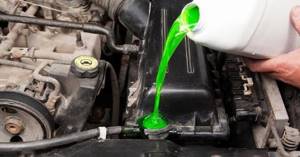
In addition, pollutants begin to appear in the coolant and flow throughout the cooling system. If you do not replace the coolant in a timely manner, dirt will begin to clog the engine water passages, which will subsequently lead to engine overheating and costly repairs.
Replacement frequency
Many auto mechanics advise replacing antifreeze every 50 thousand kilometers or every two years. However, this applies to antifreeze and antifreeze class G11. Due to the improved formula, the lifespan of G12 and G13 class coolants ranges from 100 to 200 thousand kilometers. The service life of the coolant depends on the condition of the anti-corrosion additives. When anti-corrosion additives decompose into base elements, the engine, radiator and cooling system elements are subject to electrolytic corrosion. In certain cases, the coolant may deteriorate much earlier than expected. Therefore, it is important to regularly diagnose the coolant.
You can check the condition of the antifreeze using a universal coolant composition monitoring kit. In addition, you can try to determine the condition of the liquid by eye. Cloudy white coolant indicates that it has lost its beneficial properties. A red-colored liquid indicates the presence of rust. If there are dense formations, flakes and foam in the coolant, it is necessary to immediately replace the fluid and diagnose the cooling system.
This is interesting: How many seasons can you drive on one set of tires - the shelf life of car tires
Types of non-freezing liquid for heating
Having decided that non-freezing coolants for the heating system should only be of factory quality, you can begin to select a specific composition. It must be adapted to a specific heat supply scheme, and its performance indicators cannot worsen the parameters of the system.
Before pouring non-freezing liquid into the heating system, you need to find out whether it will negatively affect the heating components. To do this, you should read the instructions for use, which must be included. It is also important to pay attention to the main component of the antifreeze fluid for heating boilers. Not only the condition of the heat supply components, but also the operating conditions depend on this:
- Ethylene glycol . Characterized by high toxicity. Therefore, it can only be used in closed circuits. Difficulties may arise when pouring this type of freezing liquid into the heating system. In a vapor state, it is hazardous to human health;
- Propylene glycol . In fact, it is a food additive, so it can be used in both open and closed heating systems. In contrast to ethylene glycol, the crystallization temperature is +80°C, which makes it possible to use it to operate high-temperature solid fuel boilers. The only drawback is the high cost;
- Glycerin . The most popular type of non-freezing liquid for stove heating. Its performance qualities are slightly lower than those of propylene glycol. However, at the same time, the cost of glycerin antifreeze is an order of magnitude less. Disadvantages include high turnover. This may affect the tightness of the pipelines. The solution is to replace the rubber gaskets with paronite gaskets.
Currently, the use of non-freezing liquid for a home heating system based on glycerin is the best option.
Differences between antifreeze and antifreeze in terms of performance
Antifreeze differs in its performance characteristics from antifreeze: it is worth remembering that the old Soviet refrigerant was made according to an outdated recipe and quickly loses its characteristics when the engine reaches high temperatures. Also, the Soviet refrigerant is not able to serve as a full replacement for antifreeze and is not able to protect the car engine when it reaches a temperature of 100 degrees.
It is important to consider: if you are planning to replace antifreeze in your foreign car, then remember that the color will help in choosing the right mixture for the engine and, in general, can be the best distinguishing feature of a company that develops and manufactures engine coolants.
- Antifreeze in its general consistency is slightly runny in comparison with the same antifreeze and therefore resembles water.
- How to distinguish one refrigerant from the other? To be able to more accurately find out what you purchased for the car and protect your engine from counterfeiting and possible breakdowns during the operation of the car, try to pay attention to the size of the container in which the mixture in the form of refrigerant is actually stored. For example, many companies with a certain reputation try to value it and put a certain type of designation on the canisters with pressed letters and a multi-stage label.
It is important to consider when purchasing antifreeze: before replacing, it is important to accurately verify its authenticity - for this, look at the label. If you purchased refrigerant concentrate from a store, before using it.
- To preserve the cooling system mechanism longer, do not mix antifreezes with each other. Even if they are the same color (colors were discussed above in the article). However, if you really want to, you can check the refrigerants yourself.
- In a separate basin or bucket, mix refrigerants of different series and look at the result. If a certain flocculent sediment appears, then the compositions should definitely not be used.
- Additives in antifreeze can protect the engine from damage and save it from freezing, in addition, multiple tests have proven all this in practice.
- Working over a huge temperature range, cooling antifreezes are perfect for a wide range of car brands, which makes them more versatile.
- Before replacing, it is important to consider that antifreeze has a weak freezing threshold and a sufficient boiling threshold, in comparison with the same Soviet refrigerant.
- From this we can draw a logical conclusion that antifreeze can reliably maintain its characteristics within the limits of up to +50.
- Other advantages of antifreeze include its anti-corrosion qualities. This makes it possible to maintain a suitable temperature range for motor operation.
All the main nuances have been discussed. Next, we’ll try to figure out how to change antifreeze on our own.
Antifreeze should be replaced only and only when the engine is cold, and it is better to do this indoors. Although you can do this on the street. Carrying out basic replacement operations on a hot engine is quite risky and can lead to unpleasant consequences, since the average temperature can reach 100 degrees.
To replace the refrigerant, you should find the cap in the radiator and remove it, then find the drain plug for the radiator and open it, insert a basin or small bucket under it in advance. This is where you should pour out all the old coolant mixture from the radiator compartment. Next, we remove the refrigerant and check the internal system for any damage or failure. If there are faults in the cooling system, it is worth repairing it if necessary.
- Before you can add antifreeze to the car, the entire system should be cleaned and washed with a rag. This is done in order to remove rust and dirt residues that ordinary water cannot cope with.
- To flush the inside of the cooling system, special products from a car store are usually used. It is necessary to add these products (although much depends on the type of product) to distilled or filtered water and pour into the tank. In this case, you close all open necks.
- What do we do next? The next step is to turn on the engine and wait a certain time while it is idling. We are waiting for the engine to heat up to a certain value.
- After all the above steps, you should “turn off” the engine and wait until it cools down, and finally pour out the dirty liquid.
- Let your engine cool down and drain all the water before adding new coolant. After all the steps mentioned above, you should calmly fill in new antifreeze. Then you should “turn on” the engine and turn on the internal heating inside the car to the highest setting.
- After a week of driving, look under the hood and see what level the antifreeze is and, if necessary, you can add the required amount there to the designation.
- To carry out a planned replacement of the working refrigerant in your car, it is ideal to replace the old refrigerant with the highest quality and most expensive one - it is better to replace the antifreeze with the original one that was used at the factory.
But a reasonable question arises - how can you understand this for sure and where can you find such antifreeze in the store?
Follow the tips and tricks of the manufacturer, which was indicated in the instructions for the car.
If you were unable to find out the type of cooling mixture used, then you need to purchase only antifreeze with the designation G12 - it is considered the highest quality and at the same time universal.
How to properly dilute antifreeze concentrate: proportions

Hi all! If the car has an internal combustion engine, antifreeze will be simply indispensable for its normal and efficient operation. In this case, the engine cooling fluid requires periodic replacement. This raises the question of how to dilute antifreeze concentrate and what proportions should be observed correctly.
You probably know that there are ready-to-use mixtures on sale. These are the same concentrates, pre-diluted by manufacturers with a certain ratio of components. The concentrate is also sold along with the diluted product. Many people do not notice the difference and pour this liquid into the system.
I will say right away that you should definitely read the instructions and composition before purchasing and pouring. If you see the word concentrate, you will need to prepare the mixture before it enters the cooling system.
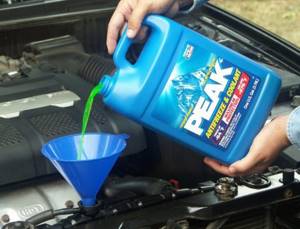
How to dilute antifreeze
You will need
Instructions
The basis for the production of antifreeze is ethylene glycol. An aqueous solution of the specified chemical substance with water in equal proportions is not inferior in frost resistance to undiluted liquid (within minus 40 degrees). As for anti-corrosion properties, diluted ethylene glycol, when heated, is up to two hundred times more aggressive towards metals than plain water. To minimize the activity of "Tosol", various additives (corrosion inhibitors) are added to it. It is precisely the difference between the chemical inhibitors added to Tosol and foreign-made antifreezes in the form of additives that distinguish domestic and imported antifreeze liquids, which are strictly prohibited from mixing. Otherwise, in one winter you can cause such damage to the car that it will require replacing the cooling and heater radiators, the water pump, and sometimes the engine cylinder head.
It is also necessary to emphasize the following: Russian “Tosol A40” is an aqueous solution of ethylene glycol in a ratio of 45:53:2. (45 – distillate, 53 – ethylene glycol, 2 – additives).
Thanks to additives (corrosion inhibitors), the water jacket in which “Tosol” circulates is covered with a protective film that preserves the surface from corrosion, and the addition of any amount of distillate to it is contraindicated, contrary to widespread belief about the possibility of such mixing. If you don't want to damage the engine cooling system, then never do anything like that.
Taking into account all of the above, only Antifreeze A40 or its analogues can be added to the cooling system of cars filled with domestically produced antifreeze. It is usually topped up to the top mark of the expansion tank.
Why is the concentrate diluted?
I’ll answer one popular question right away. It concerns whether it is possible to pour concentrated liquid without diluting it first. No, you absolutely cannot do this, since the consequences could be extremely sad. The caustic composition can damage cooling system components.

Let's look at the antifreeze itself. The coolant's job is to constantly maintain a stable engine operating temperature. Depending on the motor itself, its normal temperature can be from 90 to 110 degrees Celsius. Some heat up even more, which is quite normal for certain internal combustion engines. If the temperature parameters go beyond these limits, overheating will occur with all the ensuing negative consequences. Not only does the expansion tank cap rip off in the car, but various other destructive processes also occur. The water pump may also be damaged.
How did antifreeze come about?
Initially, vehicle cooling systems were air-based. However, people quickly realized the unreliability and low effectiveness of this method. This is how liquid cooling systems appeared. For quite a long time, ordinary water was poured into it, but this also suited few people.
The fact is that water boils already at 100 degrees Celsius and freezes even at a slight minus. Having turned into ice, it expands and increases in volume, which leads to ruptures of pipes and hoses, other breakdowns and engine failure.
Therefore, scientists have developed antifreeze - a special coolant that has a much larger temperature range than water, does not expand when frozen, and has other useful functions. Anti-corrosion, anti-foam and other additives are added to modern coolants, which also protect the cooling system.
What to use for dilution
Everyone decides for themselves whether to use a concentrate or a ready-made composition. The convenience of its use speaks in favor of the second option. Be sure to keep a canister of coolant in your car. Deficiency, contamination and simply loss of your coolant can be one of the reasons for engine overheating. The consequences may be unpredictable, but certainly expensive to eliminate.

If you choose a concentrate, be sure to decide on the manufacturer and its type. There are compositions marked G11, G12, G13, the composition can be green or red. In order not to repeat myself, I suggest you read our material on mixing antifreeze, where you will get answers to all your questions. In the meantime, let's talk about an equally significant point, which concerns the preparation of finished cooling liquid based on a concentrated composition. After all, so much has already been said about dilution, but no one has yet answered with what exactly needs to be diluted.
Antifreeze is a liquid that simultaneously prevents the engine from overheating, cooling it, and keeps it clean, protects it from additives, rust, sediment and other types of contaminants, including corrosion.
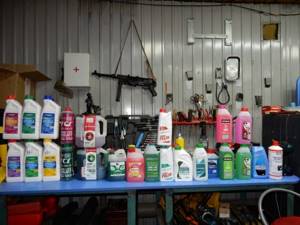
Some people dilute the concentrate with tap water. This is absolutely wrong, since such water contains chlorine, magnesium, calcium and other components that are dangerous to water. They clog the internal channels of the cooling system, reduce its efficiency, provoke rust formation, etc.
The concentrate can only be diluted with purified distilled water.
The peculiarity of this water is the absence of harmful impurities. Just don't run to the pharmacy for it. Car dealerships sell cans of various sizes for little money. My wife suggests that it is useful to use the same water for irons, as it prevents the formation of scale.
Usually the manufacturer himself indicates how and in what proportions dilution is carried out using strictly distilled water. There is a table on the label indicating all the parameters.
But it happens that there is nothing in the instructions, it has been erased or lost. Then you can build on the following recommendations. I will indicate the temperature range from the freezing threshold to the boiling threshold, and the proportions of water and concentrate that should be used:
- from -7 to +100 degrees Celsius - 87 by 13% (water and coolant, respectively);
- from -15 to +100 – 75 at 25%
- from -40-45 to 130-140 degrees - 50×50%;
- from -50-60 to +150-160 degrees - 40×60% (more concentrate than water);
- from -70 to +170 degrees – 25×75%.
In this case, the principle that more water makes the freezing point lower does not apply.
When diluting, be sure to use these proportions and do not violate the manufacturer’s recommendations. If you fill it with a lot of water, the properties of the coolant will be lost. Too concentrated a liquid can also harm the system and engine.
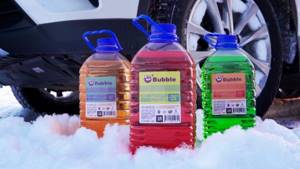
Antifreeze - we destroy myths, clarify and find out everything about this composition + video
The “old guard” of motorists knows well what antifreeze is for and how it differs from imported antifreeze, but the younger generation will be curious to know about this coolant. In addition to these questions, we will also consider the rules for replacing it.
This product is a liquid that circulates in the cooling system. It is also one of the varieties of antifreeze based on ethylene glycol, but only domestically produced. Its main tasks are to cool the engine in warm weather and prevent freezing of the working fluid in winter, as well as to protect the internal container from corrosion.
Depending on the labeling, the composition of the antifreeze, its density and, accordingly, its properties will vary. The following indices are used in the classification: A, M, K, 30, 40, 65. The letters indicate the type and are deciphered accordingly - automobile, modernized and concentrate. The numbers are the freezing temperature of this model of domestic antifreeze. The markings may also contain abbreviations for the names of manufacturers.
There are no coolants with a freezing point below 65 degrees Celsius, and it is the concentration of a substance such as ethylene glycol that provides different crystallization conditions. In addition to it, any, even domestic, antifreeze includes a set of additives, usually about 8–15, their purpose is to protect all pipes and components of the system from corrosion.
Antifreeze - technical specifications and purchase rules
Once at the counter in an auto store, most are perplexed as to which color of antifreeze is better, because they were not prepared for such variety. The answer is not that complicated! This parameter does not affect any quality characteristics; it is just a dye added by the manufacturer. Its main purpose is to differentiate brands and allow them to be mixed, for example, in model “40” the liquid is often blue, and “65” is red. It is also used for safety, since without dye, antifreeze has a transparent white color.
The boiling point of antifreeze usually lies in the range of 104–112 degrees Celsius; as for imported antifreeze manufacturers, it reaches 120–130. When purchasing, one of the ways to check quality is to measure the density; a good indicator is the limit from 1.060 to 1.090 g/cm3. Before going to the store, you need to determine what brand of coolant is in your car, and to do this, you should refer to the owner's manual. You can also find application rules there.
Typically the composition is designed for 3 years of use or approximately 80 thousand kilometers. Also, do not waste money on cheap homemade liquid; choose familiar logos on the packaging.
We will replace the coolant yourself
Despite numerous warnings, antifreeze and antifreeze can be mixed, but some details need to be taken into account. It is best if the liquids are the same color and from the same manufacturer; you can also merge different colors, although the probability of success here is small, but still possible. So, you need to mix them together and wait for some time. If sediment appears in the new mixture, then you risk ruining the system, and if there is none, you can pour it all into the tank.
The appearance of sediment is a signal that the compounds are incompatible, and their mixture may have dangerous properties for your car. Now about the replacement process itself. Under no circumstances should you open the radiator cap when the engine is hot. Park your car in a place where there is no slope, this will ensure 100% drainage of the waste fluid. To remove the old compound, in addition to the top one, you also need to unscrew the bottom cap on the radiator. Do not forget to first place a sufficient container under it for waste.
After flushing the entire cooling system and tightly screwing the lower outlet plug, the long-awaited replacement occurs, where antifreeze is poured in in this case, it’s easy to guess - this is the upper hole. We fill the system with liquid as much as possible, and then seal it. To do this, we start the car and monitor the temperature sensor, it should show the norm, after that we top up the composition again to the top, and the process is completed. After all the operations performed, it is important to monitor the heating of the engine for some time; it should not exceed the permissible values.
Leading manufacturers
Sometimes it is fundamentally important what kind of car you have, Toyota, Ford, Volvo, Renault or a car of another brand. Each manufacturer uses a cooling system with certain parameters and components adapted to work with a specific type of coolant.
Before purchasing any liquid, check the instruction manual. As for popular and well-known concentrates, they include the following mixtures:
It’s up to you to decide whether to use Castrol or Total. The main thing is that the composition is suitable for your engine. Be sure to take this into account.
The choice of fluid for the cooling system is made based on the operating conditions and recommendations of the manufacturer of the engine, and not the coolant.
Subscribe to our website, leave comments, ask relevant questions and tell your friends about our project!
( 2 ratings, average: 5.00 out of 5)
Change or top up
If the antifreeze expiration date has not yet passed, the appearance has not changed, and the level in the tank has dropped, then the question arises: “top up antifreeze or replace it with a new one?” When examining this issue, it is worth mentioning that antifreeze consists of water and alcohol, which makes this product evaporate.
A small amount of antifreeze may leave the system, then you can add antifreeze to the mark, preferably the same or similar in composition and class.
Mixing incompatible classes of coolant - for example, silicate with carboxylate, can kill all the beneficial properties of these products. Often flakes and sediment form in this mixture, and it can also become very thick. Therefore, only coolants of the same class can be mixed and added.
If the fluid consumption was high, then you should contact a service station to diagnose the cooling system and completely replace the antifreeze.
This is interesting: Where are the fuses of the Toyota Corolla 150: block diagram in the cabin
The idea of heating antifreeze for a diesel car: basic provisions and nuances

The essence of the solution
Modern diesel engines are distinguished by the fact that they use heating of antifreeze with glow plugs in a certain temperature range. The main goal is to extend the life of the particulate filter. When cold, the fuel does not burn completely and soot is formed, which settles on the honeycomb of the filter element. As it warms up, its concentration in the exhaust gases decreases.
Structurally, the idea is presented in the form of a metal block into which special glow plugs are screwed. The housing is a component of the cooling system - a “coolant” circulates through its internal cavity. Most often, the assembly unit is integrated into the cylinder head.
The spark plugs are not always active: the ECU specifies a maximum coolant temperature below which the heater starts working. The system operates in fully automatic mode - when the upper thermal limit (60-75°C) is reached, the heater is deactivated.
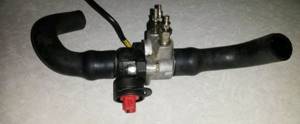
Requirements
Let’s say right away that the installation should not be regarded as pre-heating of the coolant. This is not Webasto or Eberspächer! The device operates exclusively when the engine is running - the liquid must circulate through the internal channel.
Based on the operating features of the factory coolant heater, you can create a list of requirements that must be met when assembling and installing a home-made product:
- Switching on should occur after starting the engine.
- Automatic control is carried out by a temperature sensor, which opens the power circuit when it reaches 60-75°C and supplies current to the spark plugs at temperatures below 60-75°C.
- Duplicate manual channel for selecting the operating mode.
Preparing the Cooling System
Before pouring antifreeze from concentrate, it is necessary to prepare the cooling system. The process includes:
- flushing the cooling system and the starting heater boiler;
- checking the tightness of the cooling and heating system, if damage is detected, eliminating it;
- checking the functionality of the thermostat elements, the condition and operation of the drive responsible for the radiator shutters;
- draining old antifreeze;
- pouring new antifreeze into the system;
- checking the operation of the cooling system.
Homemade heating of antifreeze in the cooling system with glow plugs: design basics
The main structural elements of the heater are the block and spark plugs. The electrical part consists of large cross-section wires, a thermal relay (thermal sensor), a fuse and an electric relay designed for high current. The main difficulties are associated with the manufacture of the housing to accommodate the heaters.
Components
When designing antifreeze heating for a diesel engine with your own hands, you should pay special attention to the number of spark plugs: two or three heaters are quite enough. An excessive increase in the number of heat-generating components is fraught - each candle has a power of about 200-250 W and consumes considerable current.
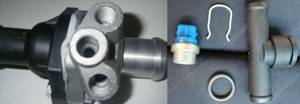
Branded heater housings are available both at disassembly sites and in retail sales. One of the options is VAG 028 121 145B for three spark plugs. Price – about 2,000 rubles. In addition to this product, it is recommended to purchase sealing rubber VAG 037 121 687. An alternative is to look at disassembly sites:
- JP GROUP 114505200.
- TRICLO 463201.
- Vaico V10-0962.
- MALO 116092.
- Renault 8200012119.
- Hyundai/Kia 97341-26100.
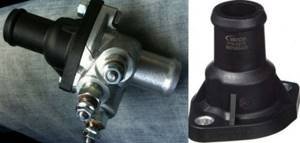
The VAG block is focused on one-way communication. Installing a plastic counter flange will help correct this issue. Its catalog number is VAG 026 121 144E. The cost is about 500 rubles. Alternative parts:
- VIKA 14253 (metal – 250 rubles).
- DELLO 301210144026E (plastic – 50 rubles).
- VAICO V100270 (plastic – 80 rubles).
- JP GROUP 1114500600 (plastic - 50 rubles).
- VAG 0261211452 (metal - 750 rubles).
For systems with automatic control, you could consider a splitter for a temperature sensor VAG 028 121 144N. But it is not recommended to use it - the sensor quickly heats up from the glow plug housing and turns off the equipment ahead of time. It is better to integrate an autonomous tee VAG 4A0 819 497.
Electrical components
The optimal temperature relay for the designed VAG 251 919 369V system. The chain breaking point is 60°C. The tape conductor design, rated for 100A, is quite suitable for the role of a power circuit fuse: VAG N10 525 506 or N10 424 905.
When choosing glow plugs for homemade heating of antifreeze, you must be guided by the parameters of the original N10 302 102:
- Thread – M12x1.25 mm.
- Installation depth – 21 mm.
- Voltage – 11.5 V.
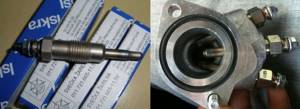
The disadvantage of the original candle is that the “plus” can only be connected using a cap. The latter is available in official auto parts stores under the code 028 971 782A. As an alternative, solutions with a nut-mounted terminal are available:
- SWAG 30915956.
- FEBI 19223.
- Bosch 0 250 201 032.
The cross-section of the power wiring is at least 4 mm2. To form a power circuit, you will need a four-contact starter relay with a rated current of about 70A, a button, a diode informing that the heating system is turned on, and a 30A control relay (four contacts). The insurance part consists of two fuses with a nominal value of 100A and 30A.

As you retrofit a diesel engine with an antifreeze heater, it is important not to deviate from the main idea - improving the heat transfer of the standard stove. Based on this, it would be logical to install the housing assembled with a flange near the stove radiator. Integrating it into the pipe leading to the heat exchanger is the optimal solution. It is better to integrate the temperature sensor into the hose coming out of the cabin radiator.
Connection
The electrical circuit is shown in the figure. All connection technology requirements are met:
- The control signal to the second relay is supplied by the generator (pin D+). The transmission is carried out when the toggle switch is turned on - the lamp lights up only when the engine is running.
- The circuits are protected by fuses.
- The contacts of the executing relay are designed for high current.
When connecting the circuit, it is important to calculate the total load on the generator. The resulting current should not exceed the rated value produced by the “gene” at idle. If the condition is not met, the generator must be replaced with a more powerful model, otherwise the battery will be supplied with power. Under normal conditions, the voltage drop after turning on the heater does not exceed 0.6-0.7 V.

Homemade antifreeze heating for a diesel car aims to speed up the warming up of the engine and interior. The essence of its work is that glow plugs heat the coolant when the engine is turned on in a certain temperature range. The installation is easy to assemble yourself using components from VAG.
The heater fits into the inlet of the cabin radiator, the temperature sensor into the outlet of the heater. There are no special comments regarding the installation of performing equipment. Regarding the electrical wiring connection, the only warning is not to mix up the 30A and 70A relays.
Do-it-yourself garage heating using antifreeze
Typical garage
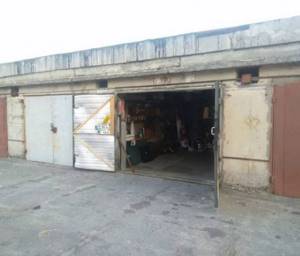
I spent the whole summer cleaning up my garage. I’ll probably write about what’s been done later. For now I’ll only tell you about heating.
When I was thinking about what kind of heating to make in the garage, I immediately rejected the option of all sorts of stoves (wood, mining, coal, etc.), because I don’t like dirt and the smell of smoke in the garage. Moreover, I just whitewashed and painted everything. Therefore, I decided to explore the option with electric water heating. Previously, when I had to work in the garage in winter, I used a 3 kW wind blower (you can see it in one of the photos). Now I decided to make water heating so that it would work constantly, and so that I would not have to monitor its operation. In addition, I wanted to make it aesthetically pleasing.
So, after the design was finally decided, a rectangular pipe with a cross-section of 60X80 with a wall thickness of 2 mm was purchased in the amount of 6 m. A register was made from it to fit the back wall of the garage.
General view of the register
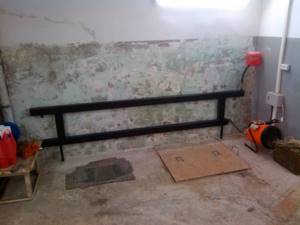
A short lyrical digression about why the rear wall of the garage was chosen. There are a couple of reasons for this. Firstly, the garage is a bit narrow. When the car is in the garage, you can’t even open the car doors completely, let alone put anything against the side walls. Therefore, installing batteries (pipes, radiators, etc.) on them is not an option at all. Secondly, I wanted to make the situation with the back wall a little easier. The back wall faces the street, so it freezes a little in winter. Because of this, a fungus grows wildly on it, which I can’t do anything to remove. In the summer I tried to plaster and paint it, but everything came off. That’s why she looks so, to put it mildly, unpresentable in the photo. In general, this is my “headache” that ruins my life. To make it freeze less, I decided to install a register on it.
Let's move on. A rectangular pipe was chosen due to its larger heating surface area compared to a round one. The large pipe is placed vertically in order to minimally cover the hole into the cellar.
Legs and stops are welded to the register, which are secured with anchor bolts (legs to the floor, stops to the wall). This was done so that the register did not load the wall, but at the same time was firmly attached to it.
Standard heating element, Aristonovsky, 1400W, with thermostat. I shortened the lower pipe so that it could be removed without removing the register itself from the wall. The heating element was connected with a suitable piece of flexible rubber cable 3x2.5 to the machine installed in the panel, which had been prudently installed earlier.
Place of installation of the heating element
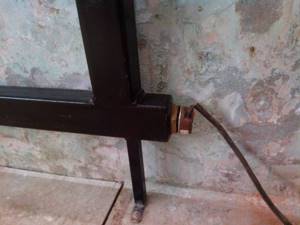
I have never dealt with ethylene glycol before, but I know that it has decent thermal expansion. Therefore, a fitting was welded into the upper pipe, a tap was installed, and an expansion tank from a “penny” was connected through a rubber hose of a suitable cross-section. Now I think that the tap is not really needed here, but don’t remove it. The neck of the expansion tank is closed with a lid to minimize coolant evaporation (someone said that it is poisonous). I used a lid from a tin oil canister. She stood up as if she had always been here.
How to make a good antifreeze at home
from


How to make a good antifreeze for your car at home? Is it possible to make it from alcohol, vodka, vinegar and other available materials? What recipes exist and in what proportions should the ingredients be mixed so that the windshield washer does not freeze in the cold? And does it make sense to make anti-freeze at home yourself for sale? About all this in our article.
There are a lot of anti-freeze products on sale today. Different types, colors and smells. Accordingly, the quality is also different. And at the same time the prices are quite reasonable. If you don’t like one, you can buy another one at the nearest store. However, despite the wide selection and availability of omyvayka, Russian Kulibins are always trying to invent something of their own.
There are many recipes on the Internet on how you can make high-quality anti-freeze for cars at home: from alcohol, vodka, vinegar, windshield cleaner, even from moonshine. It tells you in what proportions to mix all this in order to make a good antifreeze with your own hands.
By and large, the game is not worth the candle. It's easier to buy than to bother with beakers. But let's imagine that there is no other way. For example, in the middle of winter you suddenly find yourself at the end of the world and there is simply nowhere to buy auto chemicals, but you have already used yours. Then you will have to make an antifreeze from available materials.
Restrictions on the use of antifreeze in heating supply
Despite all its positive aspects, not every non-freezing liquid is suitable for heating boilers. Improper use can lead to gradual destruction of the heat exchanger and rapid failure of expensive equipment.
In addition, there are a number of other restrictions that must be taken into account when using non-freezing coolant in heating systems:
- Many models of double-circuit boilers are not designed for antifreeze. It can get into the hot water supply system, which is an undesirable factor;
- Antifreeze liquid has a negative effect on galvanized surfaces. The protective layer quickly deteriorates and, as a consequence, the heating element fails;
- Since the viscosity of antifreeze is much higher than that of water, it is necessary to supplement the heating with powerful circulation pumps. The lower the critical level of freezing temperature, the greater the productivity of the pumps;
- Antifreeze replacement should be carried out strictly according to the manufacturer's recommendations. It loses its properties over time, which directly affects the performance of the heating system.
The antifreeze concentrate is diluted only with distilled water. An ordinary flow-through system is not suitable for this - a large number of third-party elements can cause an undesirable chemical reaction.
The video details the parameters for choosing antifreeze for heating systems:
How to create the above items outside the plant/factory
The cheapest, most widespread and still used antifreeze is water. Any kind.
A soldier has eternity ahead, don’t confuse it with old age
remove the thermostat, insulate the radiator, antifreeze is ready.
Why insulate when you need to cool it on the contrary?
if winter intercepts in the radiator. look at the trucks in winter the muzzle is closed
How to make anti-freeze: main points
Whatever composition you prepare, it should:
- clean the windshield from dirt and ice;
- remain liquid at subzero temperatures;
- be safe for both humans and machine parts.
That's all, perhaps, nothing more is required from the washer.
As a rule, the base of non-freezing liquid includes ordinary distilled water, alcohol and some additives for fragrance, coloring and improving cleaning properties. Among the alcohols used in production are methyl, ethyl and isopropyl.
What is this
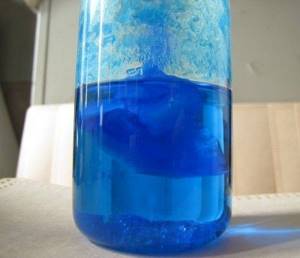
It is also used in heating systems. Translated in our language, antifreeze means “anti-freeze.” That is why it is also called anti-freeze. That is, this liquid does not freeze at subzero temperatures; it also cools the engine during operation and protects its elements from corrosion. The production of antifreeze does not have a negative impact on nature. The composition of factory antifreeze often includes ethylene glycol, propylene glycol, and glycerin mixtures
, as well as monohydric alcohols and other substances that are made on the basis of water. Sometimes more flavorings are added. Note that it is quite easy to make antifreeze at home. How exactly? Read on!
Anti-freeze made from vodka
Vodka is found in almost every home, so to make anti-freeze from it, you need to take:
- 0.5 liters of vodka;
- 0.5 liters of clean water;
- 2 tsp. dishwashing detergents (for example, Fairy).
If you absolutely want a beautiful wash, add just a little blue or potassium permanganate to the solution.
The solution is completely safe for humans and machinery. This antifreeze is suitable for temperatures above –15 degrees. In cold weather there is no need to dilute vodka with water. But if the temperature outside the window is below - 30 degrees, then pure vodka will not save you, it will simply freeze.
Process description
You might be surprised that homemade antifreeze contains alcohol. After all, it is clear that, for example, at a negative temperature on the windshield, the alcohol will evaporate, leaving only water, which itself will quickly freeze. But ethylene glycol saves everything here. It reduces the volatile property of the solution, so the alcohol does not have time to evaporate.
Often, a one to two ratio is used to prepare a solution, that is, one part alcohol and two water are taken.
This ratio can be changed if the temperature drops much below zero. At an air temperature of minus five degrees, a five-liter canister requires 0.6 liters of alcohol, at minus ten - one liter, at minus fifteen - 1.25 liters, at minus twenty - 1.65 liters, at minus twenty five - two liters, at minus thirty – 2.5.

Next, add ethylene glycol. You will have to calculate how much it is needed yourself. 15 cubic centimeters of ethylene glycol are required for each thermometer mark below zero.
Please note that ethylene glycol, like the antifreeze that contains it, is poisonous. If you are very concerned about your health, replace ethylene glycol with propylene glycol. It is much more expensive, but does not have toxic properties.
If desired, you can add natural flavoring to homemade antifreeze.
. It will remove the alcohol smell. You can use, for example, essential oil. By adding ten drops of it, you will rid the antifreeze canister of unwanted odor. We also note that you can enhance the cleaning properties of the liquid by simply adding a tablespoon of laundry detergent to it. If you adhere to all the above recommendations, then you will get antifreeze with your own hands no worse than the factory one.
On the shelves of automobile stores there is a huge selection of both ready-made coolants and concentrates. Inexperienced car owners do not notice the difference and make the grave mistake of pouring concentrated antifreeze into the engine. And this can lead to undesirable consequences, especially in winter.
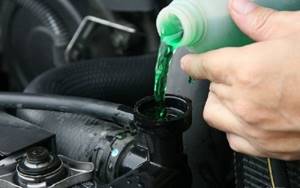
Antifreeze made from ethyl alcohol
The stronger the water-alcohol solution, the more resistant it is to frost. Base alcohol strength – 96% +/- 2%. Here is a table showing the ratio in which you need to mix water and alcohol in order to make anti-freeze from them at home for various weather conditions:
At home, you can also add a little essential oil for scent and a tablespoon of washing powder to the solution to increase cleaning properties. Just don’t pour the powder directly into the canister. Pour out 2/3 cup of water prepared for the solution and add the powder there. Stir and let sit. Then you can pour this into a non-freeze container, filtering out the sediment.
Often the recipe contains detergent. Choose a regular kitchen one that is non-aggressive towards metal and plastic.
It's great if you have some free ethylene glycol or antifreeze. Their use adds a couple of pluses to the characteristics of a homemade washer. Calculate the required volume yourself on the basis that for every degree below zero it is advisable to pour in 10–15 drops. It turns out that in severe frost you will need about 2 cups of ethylene glycol or antifreeze.
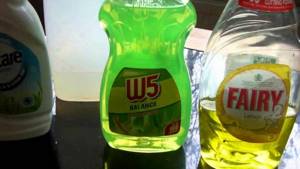
How to choose the right antifreeze
The abundance of brands and specifications of antifreeze often confuses the buyer. Most car owners distinguish antifreezes according to the following characteristics:
- name - antifreeze or antifreeze;
- color - green, red, blue and yellow coolants are available on sale;
- identification marker (G11 and G12).
In modern conditions, antifreeze is completely synonymous with antifreeze. Antifreeze was developed in the USSR in the 70s, therefore it has a domestic name. Antifreeze is the Western name for this auto chemical product; over time, it has taken root in Russia. Both are coolants and have identical functions and properties.
Although the color of antifreeze matters, it is not exactly what car owners understand. There is even a misconception that green antifreeze is of poor quality, but red is the best.
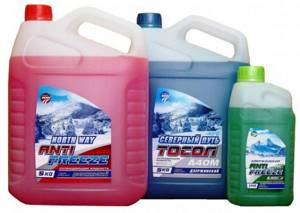
The term “coolant” is in fact the most correct and accurate designation for such compositions
Of course, the recommendations not to mix antifreeze of different colors should be followed, but you cannot rely only on color. The color is given to antifreeze using dyes at the factory; it is intended primarily for the manufacturers themselves, so as not to confuse product batches.
The manufacturer may well paint the coolant a certain color, although its chemical composition may not be compatible with antifreeze of a similar color from another factory.
Another marker gradation (G11 and G12) is also not entirely logical. It is intended exclusively for cars of the VAG concern (Volkswagen, Skoda, Audi, etc.), which developed it. Therefore, it is not entirely correct to apply such a classification in relation to other car brands. For example, G11 antifreeze was intended only for VAG cars up to the year 96; subsequent models required G12 coolant. Antifreezes with the G11 index are still offered on the auto chemical market. But if G11 from VAG contained silicates, then modern products with such a marker often contain borates and even phosphates, which contradicts the very principles of this classification.
The conclusion from this difficult situation is very simple. You should not select antifreeze solely by color, index or name. You just need to look at the car manual and find the brands and names of coolant recommended by the manufacturer. Each factory specifies acceptable technical fluids, including antifreeze, so you should only rely on the car’s owner’s manual. Just fill in the coolant recommended by the car manufacturer, and you don’t have to worry about your choice.
Anti-freeze from moonshine
Before you make anti-freeze for a car from moonshine, it would be nice to know how many degrees there are in your “primary”. If it was prepared for food use, it is 30–40 degrees. If it’s for medical or technical purposes, it can be all 90 degrees.
High-percentage or poorly distilled moonshine contains methanol and acetone. But you shouldn’t be too afraid of this. The concentration of these poisons (let's call them that) makes moonshine hazardous to health when consumed internally, but it is unlikely to damage the washer pipes and reservoir. Just in case, be careful: do not sniff the solution.
Anti-freeze based on 90% moonshine is made in the same way as from ethyl alcohol, only adjusted for strength. If it is a food substitute, use the vodka omyvayka recipe. But again, consider the mass fraction of alcohol. That is, if you are not sure that your moonshine is 40%, pour a little more of it into the canister than necessary.
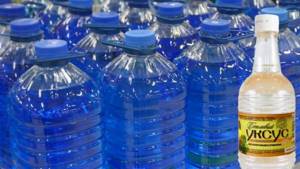
Process description
You might be surprised that homemade antifreeze contains alcohol. After all, it is clear that, for example, at a negative temperature on the windshield, the alcohol will evaporate, leaving only water, which itself will quickly freeze. But ethylene glycol saves everything here. It reduces the volatile property of the solution, so the alcohol does not have time to evaporate.
Often, a one to two ratio is used to prepare a solution, that is, one part alcohol and two water are taken.
This ratio can be changed if the temperature drops much below zero. At an air temperature of minus five degrees, a five-liter canister requires 0.6 liters of alcohol, at minus ten - one liter, at minus fifteen - 1.25 liters, at minus twenty - 1.65 liters, at minus twenty five - two liters, at minus thirty – 2.5.
Next, add ethylene glycol. You will have to calculate how much it is needed yourself. 15 cubic centimeters of ethylene glycol are required for each thermometer mark below zero.
Please note that ethylene glycol, like the antifreeze that contains it, is poisonous. If you are very concerned about your health, replace ethylene glycol with propylene glycol. It is much more expensive, but does not have toxic properties.
If desired, you can add natural flavoring to homemade antifreeze.
. It will remove the alcohol smell. You can use, for example, essential oil. By adding ten drops of it, you will rid the antifreeze canister of unwanted odor. We also note that you can enhance the cleaning properties of the liquid by simply adding a tablespoon of laundry detergent to it. If you adhere to all the above recommendations, then you will get antifreeze with your own hands no worse than the factory one.
Antifreeze made from vinegar
If you don’t have any alcohol or vodka on hand, you can make your own anti-freeze for your car at home using regular 9% apple cider vinegar. Yes, yes, from the same one that is in the kitchen of 99% of housewives. Cheap and cheerful!
Just take half a liter of vinegar, the same amount of clean water and a couple of spoons of dishwashing detergent. Mix everything, and the washer is ready. True, in cold weather it will freeze quickly. It can be used up to a maximum of –10 degrees. Vinegar also smells strongly and, when used for a long time, spoils the pipes: it makes plastic and rubber less elastic and more fragile.
How to drain coolant
Step by step:
- Place the canister under the drain bolt.
- Disconnect the pipe from the radiator.
- Unscrew the valve on the tank that controls the flow. When all the liquid from the radiator has been drained, drain it from the cylinder block (BC).
- Remove the dust shield. Open the heater tap inside the car so that no liquid remains in the heater radiator.
After draining the antifreeze or other liquid, we proceed to flushing the system. Deposits accumulate in the radiator and engine cooling jacket and need to be flushed.
Antifreeze from other means
If it so happens that you don’t have vinegar, alcohol, or even vodka at home, you can make anti-freeze in the washer with your own hands from ammonia, window cleaner or a good dishwashing balm. Here are the recipes:
- 0.4 l of window cleaning liquid (windshield wiper) + 0.6 l of water.
- 1 tsp. dishwashing detergent + 1 liter of water.
- 0.2 l of ammonia solution (ammonia) + 0.6 l. water.
Please note that all three types of washer are not designed for very low temperatures. They are more for the off-season.
Video
Replacement of coolant for Renault Logan, Sandero, Duster, Lada Largus.
How to replace antifreeze on VAZ 2101, 2102, 2103, 2104, 2105, 2106, 2107.
Replacing coolant on front-wheel drive VAZs.

If you are the owner of a car, then you probably know that after the car has driven several tens of kilometers, it is necessary to fill the system with antifreeze fluid. You have to buy it all the time. But, there is a way to save money. And in our article we will tell you how to make antifreeze with your own hands.
How to make anti-freeze yourself: important rules
So, all the recipes on how you can make antifreeze right at home have been given to you. What else is required? So that your home washer does not harm the car and you too. That's why:
- If possible, choose components without a strong odor.
- Do not use components for preparing anti-freeze, which may damage the washer.
- Start with a test sample. First, make 100-150 grams of anti-freeze and test. Apply it to the glass and also place it in the freezer for a while to see if the solution freezes and how quickly it does.



